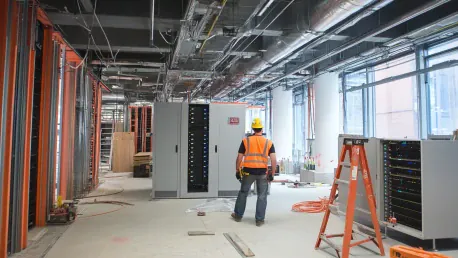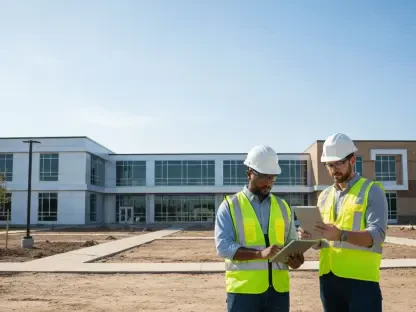With the escalating demand for digital infrastructure, the New York City (NYC) Metropolitan Area has emerged as a significant hub for data center development. This growth is not without its set of challenges and opportunities that key players in the industry, including developers, Real Estate Investment Trusts (REITs), and facility managers, must navigate. The future of data center construction in NYC is shaped by factors such as power constraints, sustainable construction practices, labor shortages, cybersecurity concerns, AI-driven efficiencies, and increased investment from REITs.
Power Constraints and Grid Challenges
One of the primary issues confronting data center construction in NYC is power availability, which has become a critical choke point for new projects in this region. Power constraints are likely to worsen as the demand for AI-driven workloads and cloud services grows. Chris Nangano, the director of Mission Critical at Doyle Construction, points to the sustainability of the electrical infrastructure as a pivotal concern. The increasing strain on the electrical grid raises pressing questions about its ability to support the growing demands of data centers alongside the expansion of AI technologies.
To address these power constraints, there is growing collaboration between data center developers and power utility companies. This collaboration aims to focus on grid-ready locations and develop effective backup power solutions. The goal is to ensure that data centers can continue to operate efficiently despite the increasing power demands. Investments in renewable energy sources, such as solar and wind power, are also being explored to provide sustainable power solutions for data centers, reducing their reliance on traditional power grids.
PropTech’s Role in Sustainable Data Center Construction
To enhance sustainability and reduce power consumption, developers are increasingly turning to PropTech solutions. Greg Silverman, VP of Sales at MHT Technologies, highlights the integration of Power over Ethernet (PoE) systems as a promising method for improving energy efficiency and operational effectiveness. By adopting PoE, data centers can significantly decrease their energy consumption and enhance their overall operational efficiency.
Additionally, AI-driven energy optimization and smart building management systems (BMS) are becoming crucial in driving sustainable construction practices. These advanced technologies enable real-time tracking of energy usage and operational efficiency, helping data centers to minimize inefficiencies and ensure compliance with NYC’s evolving energy regulations. Digital twins are also being used to simulate and refine designs before construction, ensuring that data centers are built with maximum efficiency from the outset.
Paul Soames, the owner of Ryan Soames Engineering, emphasizes the importance of understanding electrical load, diversity, and future expansions while considering renewable energy opportunities for long-term sustainability. Combining these approaches allows data center developers to create energy-efficient and sustainable facilities that can meet the demands of the future.
Labor Shortages and Workforce Challenges
Despite the high demand for new data center projects, the industry faces significant challenges due to a shortage of skilled labor. This labor shortage leads to project delays and increased construction costs. Chris Nangano notes that this issue affects both field and management levels, with an aging workforce and fewer young professionals entering mission-critical construction roles.
To address these workforce challenges, companies are expanding apprenticeship programs to attract and train new talent. These programs provide opportunities for hands-on learning and skill development, helping to bridge the gap created by the labor shortage. Additionally, automation in construction is becoming more prevalent, reducing the reliance on manual labor and improving overall project efficiency.
Modular prefabrication is another method being employed to address labor shortages. By constructing data center components off-site and then assembling them on-site, developers can reduce the time and labor required for traditional construction methods. This approach not only mitigates the impact of labor shortages but also enhances the speed and cost-effectiveness of data center construction.
Cybersecurity Growing Concern
As data center construction increasingly relies on cloud-based design tools and IoT-enabled site monitoring, cybersecurity concerns have become more pronounced. The reliance on these technologies exposes data centers to a higher risk of cyber threats, necessitating robust security measures. Chris Nangano emphasizes that the threats to data centers are evolving, and proactive security measures are essential to protect sensitive information.
Developers are addressing these cybersecurity challenges by implementing end-to-end encryption for design and infrastructure plans. This ensures that data is protected during transmission and storage, reducing the risk of unauthorized access. Secure digital collaboration platforms are also being used to facilitate safe communication and data sharing among project stakeholders. Additionally, strict access controls are being implemented to prevent unauthorized access to sensitive information.
These measures are critical for safeguarding data centers against cyber threats and ensuring the security of valuable information. As cybersecurity concerns continue to evolve, data center developers must remain vigilant and proactive in implementing advanced security solutions.
AI’s Impact on Construction Efficiency
AI is revolutionizing the data center construction industry by enhancing project management and efficiency. The integration of AI-driven solutions is streamlining operations, allowing teams to focus on strategic decision-making rather than administrative tasks. Chris Nangano believes that incorporating AI technologies into data center construction can significantly improve project outcomes.
Predictive maintenance is one such AI-driven solution that helps ensure the reliability of on-site equipment. By analyzing data from sensors and monitoring systems, AI can predict equipment failures before they occur, allowing for timely maintenance and reducing downtime. Automated materials tracking is another AI application that helps prevent supply chain delays by ensuring that construction materials are delivered on time and in the right quantities.
Algorithmic scheduling is also being used to optimize workforce deployment, ensuring that construction tasks are efficiently allocated and completed on schedule. This reduces the likelihood of delays and enhances overall project efficiency. By leveraging AI, data center developers can streamline operations, improve project management, and achieve better construction outcomes.
REITs and Future Investment in NYC Data Centers
The perception of data centers by commercial real estate investors has evolved significantly, with data centers now being recognized as valuable assets comparable to traditional commercial spaces such as office and retail properties. This shift is reflected in the actions of major NYC REITs, such as Vornado Realty Trust, which are exploring data center partnerships and expansions. Similarly, COLO providers like Digital Realty and Equinix are actively expanding their NYC-based assets.
Investment firms like Blackstone and Brookfield are also allocating significant capital to hyperscale data center developments, signaling a broad recognition of data centers as critical infrastructure. These investments highlight the growing importance of data centers in the digital age and their potential for long-term value appreciation.
The increased investment from REITs and other commercial real estate investors is driving the growth of data center construction in NYC. This influx of capital is enabling the development of state-of-the-art facilities that can meet the demands of modern businesses and ensure the reliability and security of digital infrastructure.
Future Projections
The future of data center construction in NYC will be influenced by several key factors, including sustainability mandates, AI-driven efficiencies, and strategic power collaborations. Developers will need to remain agile in response to power constraints, labor shortages, and evolving cybersecurity risks to capitalize on the next generation of mission-critical real estate.
The insights from industry experts highlight the importance of collaboration, technological integration, and forward-thinking strategies in navigating the dynamic landscape of data center construction. By addressing these challenges and leveraging innovative solutions, the industry is poised for continued growth and resilience.
Looking ahead, data center developers in NYC must prioritize sustainability and energy efficiency to meet evolving regulatory requirements and reduce their environmental impact. The integration of AI-driven solutions and PropTech will be crucial in optimizing construction processes and improving operational efficiency. Efforts to address labor shortages through apprenticeship programs and modular prefabrication will also be essential in ensuring the timely completion of projects.
Connection and Implications
With the rising demand for digital infrastructure, the New York City (NYC) Metropolitan Area has become a major hub for data center development. This growth brings a unique set of challenges and opportunities that key industry players—developers, Real Estate Investment Trusts (REITs), and facility managers—must navigate. Several factors are shaping the future of data center construction in NYC. Power constraints are a major concern, requiring innovative solutions to ensure a stable energy supply. Sustainable construction practices are gaining importance to reduce environmental impact. Labor shortages pose another challenge, affecting timelines and costs. Cybersecurity concerns must be addressed to protect sensitive data. AI-driven efficiencies offer opportunities for optimizing operations. Additionally, there’s significant increased investment from REITs, fueling the development of advanced data centers. Addressing these factors is crucial for the continued growth and success of this burgeoning sector in the NYC metropolitan area.









